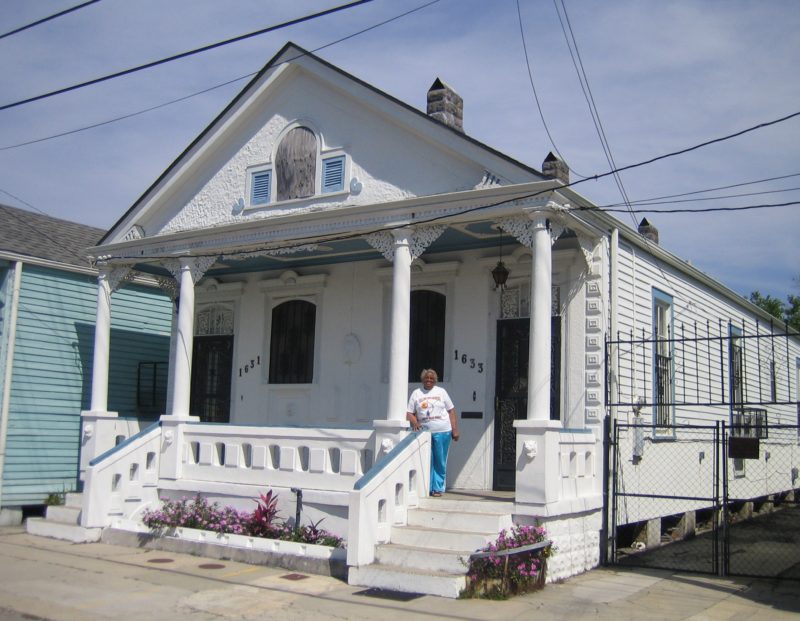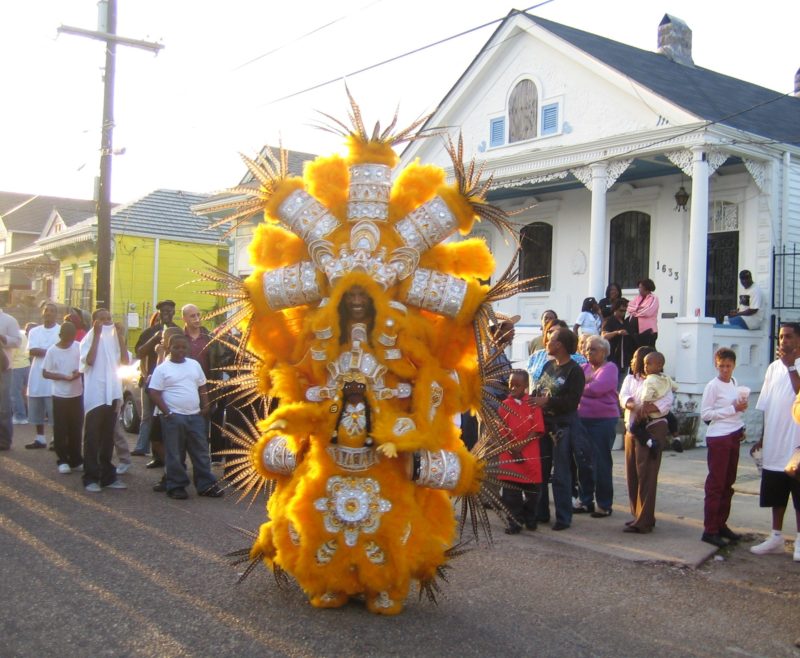
The famed Montana Family House in the seventh ward. Photo by Bethany Roberts.
At first glance, the Montana family home on North Villere Street is a charming double shotgun with detailed touches, like many others in the Seventh Ward. With a closer look, though, you notice features you do not see on other houses: unique arched openings in the handrails, decorative cut-aways in the transom windows, and, centered on the front of the house, a cast plaster face of Big Chief Allison “Tootie” Montana wearing an Indian headdress. “Tootie used to always say, ‘I have to put some of my work in my house,’” Joyce Montana, the wife of the late Big Chief, explains about the mini-monuments to her husband’s legacy as a celebrated plasterer and lather all around and inside her house. “He always had a measuring stick,” Joyce notes, articulating how the Chief’s work in the building trades complemented the kind of creativity and geometry needed to craft the dazzling, three-dimensional Indian suits Tootie is famed for. Known as the “Chief of Chiefs,” Tootie masked Indian for 52 years, 50 of them consecutively, and now his son Darryl Montana heads the family tribe, the Yellow Pocahontas, bringing his own signature innovations to Indian suit design. Large meals and fellowship at the Montana house in the Seventh Ward have been an integral part of designing and sewing the family’s Indian regalia, and Joyce continues to cook up her popular gumbo, fried fish, and potato salad and have extended family over to visit. A professional at intricate bead and sequin work, Joyce has put in countless hours at her dining room table sewing for the Montana Indian clan. Joyce’s son, Charles Andrews, is her next door neighbor; he sews on his brother Darryl’s suits and deejays the famous street parties that make North Villere Street such a popular Carnival destination.

The late Chief Allison “Tootie” Montana. Photo by Bethany Rogers.
Interview with Joyce Montana
Joyce Montana said, “We had to get up early, and I’d be preparing food for Carnival. Like my beans, I take and I put that on the night before and let ‘em soak. Cut up my seasonings and everything. And everybody said, ‘Joyce, I don’t know how you could do all you do.’ But I just got in the habit of doing that. I used to have a lot of food, a lot of drinks and sew. I used to sew in the kitchen. But then we had so many people that was comin to sew, they’d all be at the dining room table, so I’d sew up front with them, unless I was back in the kitchen cooking. I’d be back there cooking and making trips going back and forth. But it was fun, cause you always had a lot of company, and, oh honey, people would be so happy to be here with Tootie comin out that Tuesday. Everybody wanted to be out here with him.”
Interview with Charles Andrews
Charles Andrews, Joyce’s son and neighbor on Villere Street, said, “I tell you what. Me and Joyce was outside yesterday evening and we were just sitting on the steps on the other side and two little young girls, one was about 12, one was about 8, and one of the little girls hollered, ‘You see that house right there? I know whose house that is. That’s Tootie Montana house.’ And see, I’ve been a deejay for 35 years and a lot of people know me. When they pass here they say, ‘That’s Brother Charles’ house. That’s Tootie Montana’s house.’ When they come around here for Mardi Gras, Brother Charles plays the music next door to Tootie Montana’s house. You got the people dancing in the street. So that comes like a combination.”







